
Introduction
IP geolocation has become an essential tool for determining users’ locations on the internet, offering vast opportunities for business, security, and personalization. However, IP geolocation is full of hidden nuances, errors, and limitations that can lead to unexpected consequences. This article explores how IP geolocation is influenced by political boundaries, the impact of VPNs and mobile networks, and examines curious and legal cases related to geolocation.
How Political Boundaries and Sanctions Affect IP Geolocation
Depending on political conditions and sanctions, IP geolocation databases may restrict certain regions or even assign “conditional” locations to IP addresses in disputed areas. For instance, addresses in Crimea or parts of the Middle East may be marked as “undefined” or automatically assigned to the nearest region. This creates challenges for companies required to comply with sanctions and legal regulations. Users from these zones may lack access to certain services, sometimes leading to conflicts and disputes.
Geolocation in Mobile Networks and “Jumping” IPs
In mobile networks, IP geolocation is often inaccurate. Users may move between regions without changing their IP, or conversely, their IP may change when connecting to different towers. Additionally, many mobile operators assign IP addresses not to specific locations but to central network hubs, leading to curious results. For example, a user might be in one city, but the geolocation service shows them hundreds of kilometers away in another city.
Impact of NAT and IPv6 on Geolocation Accuracy
In corporate and provider networks, NAT (Network Address Translation) is often used, where multiple users share a single external IP address. This complicates determining the exact location, as the geolocation database shows only a general location rather than details for each individual user. IPv6 theoretically solves this issue by providing unique IP addresses for each device. However, until IPv6 is widely adopted, geolocation accuracy will remain limited.
Geolocation Anomalies as a Security Indicator
Some services monitor sudden “jumps” in geolocation to detect suspicious activity. For example, if a user logs into their account from Moscow and then, minutes later, from New York, these jumps may signal a possible hack, triggering a block or a verification request. Companies are increasingly using machine learning to analyze anomalous IP geolocation patterns and detect potentially fraudulent activities.
Geolocation Spoofing and Bypassing Geoblocks
Many users use VPNs or proxies to bypass geoblocks and change their IP location. For example, streaming platforms try to prevent users in one country from accessing content available only in another. To achieve this, companies use databases that track IP addresses associated with VPN and proxy services, frequently updating them to restrict access.
The Future of IP Geolocation: IPv6 and New Technologies
The implementation of IPv6 should enhance geolocation accuracy, allowing each device to have a unique IP address. This will simplify tracking and analyzing users’ locations. New technologies, such as machine learning and artificial intelligence, also contribute to refining IP geolocation databases, making them more accurate and reliable.
Conclusion
IP geolocation is a complex, multifaceted process involving aspects of politics, technology, privacy, and law. Despite its clear benefits for business and security, it also has many limitations and potential inaccuracies that can affect data quality. Understanding these nuances helps companies use geolocation more effectively, avoiding false assumptions and delivering quality services to users.